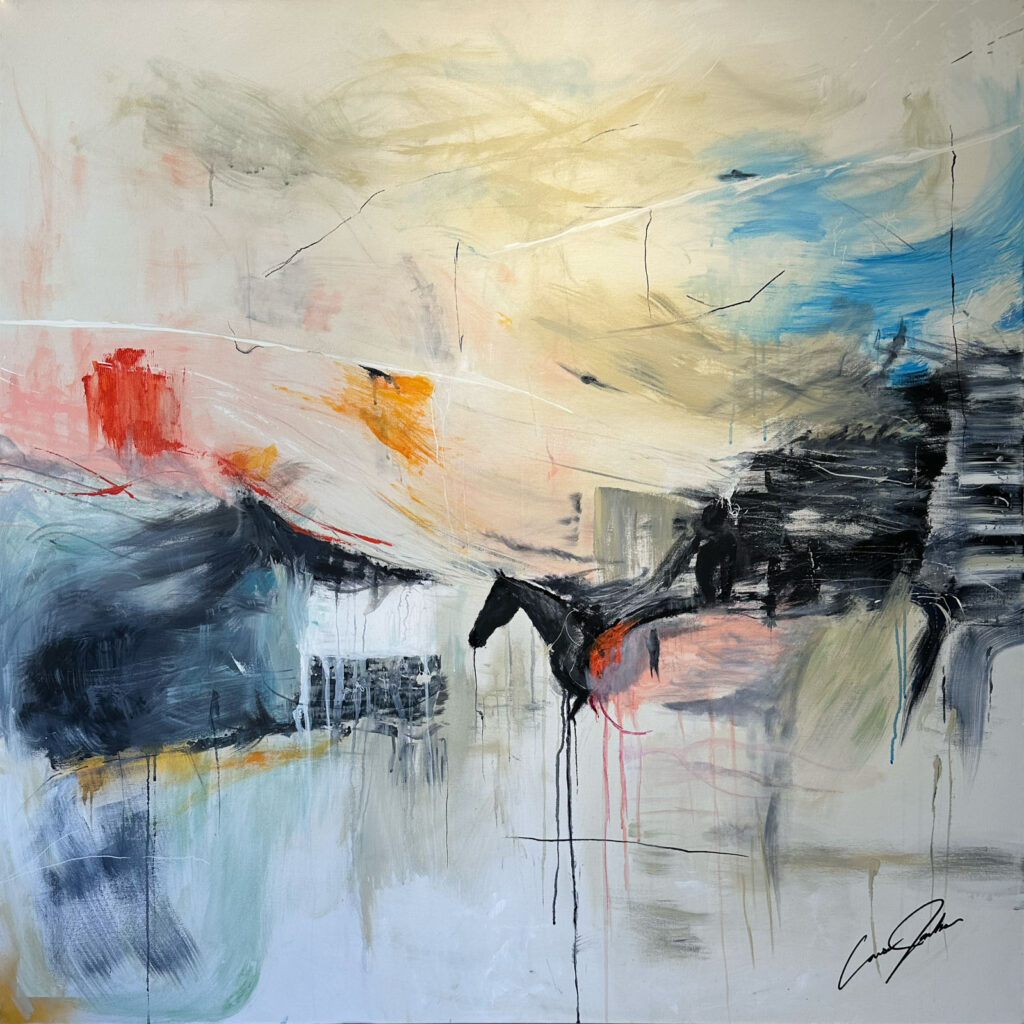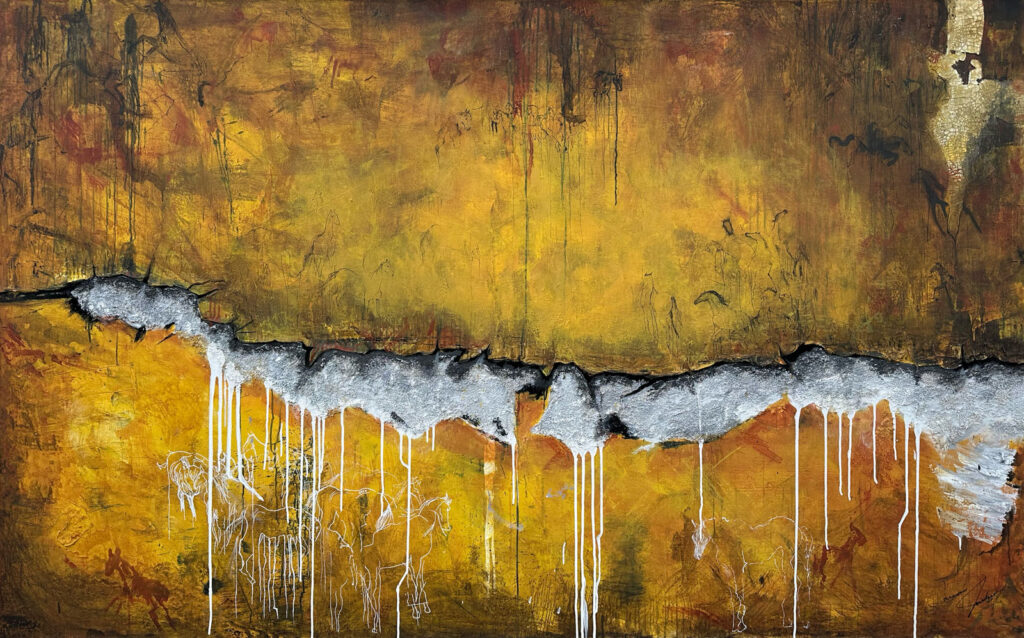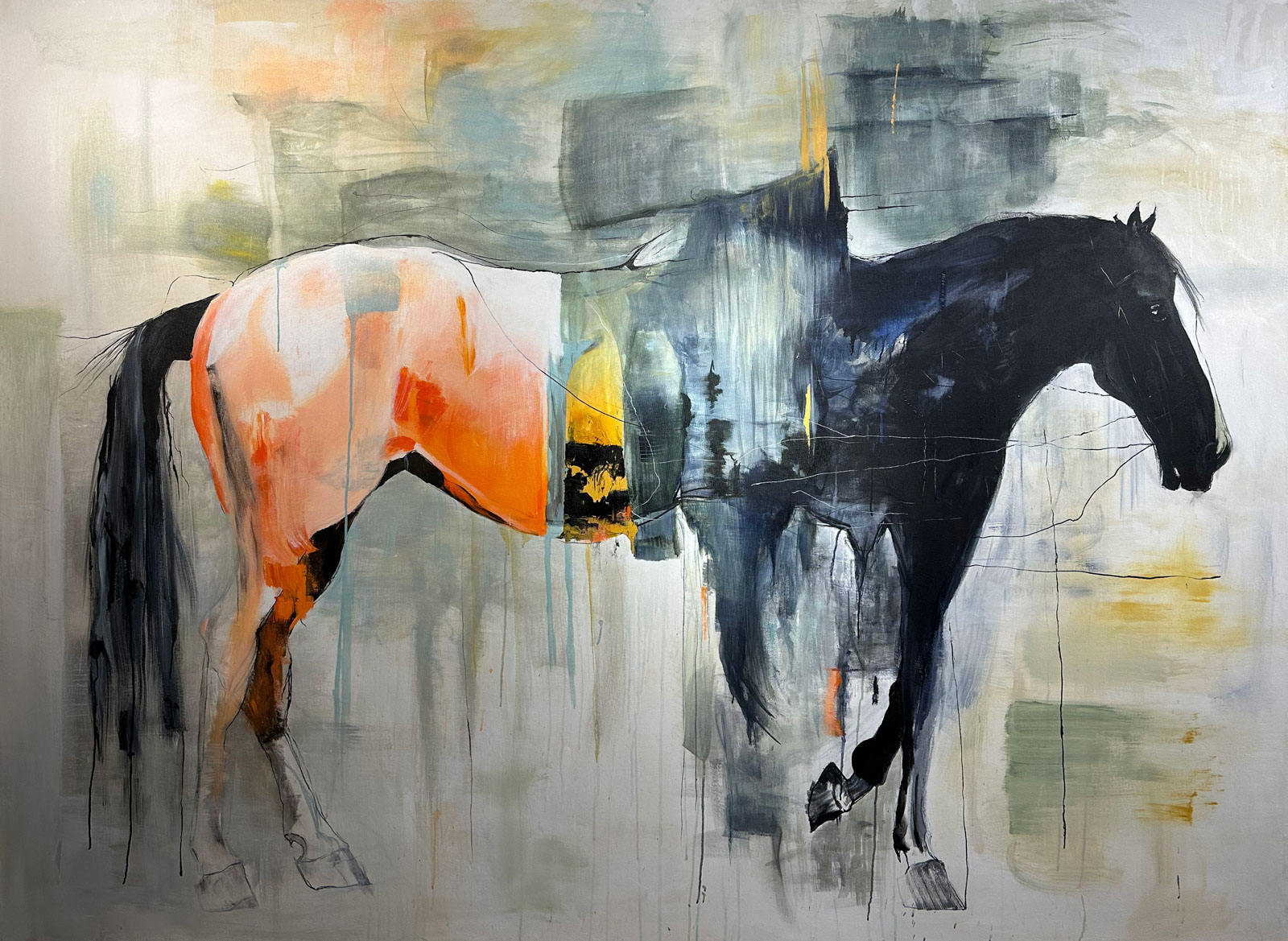Maine-based Carson Jackson, a largely self-taught contemporary abstract artist, has developed a distinctive style over his career by blending various techniques. His work challenges conventional interpretation, creating pieces that resonate with the interplay of darkness and light, often using mixed media and found objects. The son of a Cuban refugee, Jackson’s journey spans both geographic and professional landscapes, enriching his art with diverse experiences.
His travels have taken him from Ogunquit, Maine, to the surf of El Salvador, through Norway’s fjords, and to the Outer Banks. Before pursuing art, Jackson worked as a model in Central America and as a creative director, roles that deepened his artistic perspective. His previous career in healthcare, where he assisted in life-saving procedures, provides him with a unique insight into the fragility and resilience of life, infusing his work with emotional depth.
This October, Jackson will collaborate with the Boston Design Center for a landmark exhibition debuting his “Essence of the Untamed” series. This series will be showcased alongside globally acclaimed designers who integrate fine art into homes worldwide, marking a significant moment in his artistic journey.
“Dance of the Untamed” will be exhibited at Imago Gallery in Warren, RI, this October.

EQ: Your background is quite diverse, from healthcare to fine arts. How did these experiences shape your artistic vision and approach?
CJ: Each phase of my career has uniquely contributed to my artistic development. My time in healthcare honed my precision and attention to detail, qualities I transfer directly to my art, especially in the intricate textures and compositions of my pieces.
During my career in healthcare, the intense awareness of life’s fragility overwhelmed my creative spirit. Yet, it was the untamed spirit of the horse that carried me out of the fog and inspired me to dive deeper into my art. Their remarkable resilience and fight to maintain a wild nature, even when domesticated, resonates with me deeply. These qualities not only revived my artistic drive but enriched my work with profound empathy and emotional depth. This diverse background has allowed me to approach art with a holistic, detailed perspective, enriching my creative expression.
EQ: How did growing up the son of a Cuban refugee influence your perspective on life, and do you feel that it is reflected in your art?
CJ: Growing up as the son of a Cuban refugee deeply influenced my worldview and artistic expression. This background instilled in me a profound appreciation for freedom and resilience, themes that often permeate my art. It’s reflected in my choice of bold colors and dynamic forms, symbolizing the vibrancy and enduring spirit of Cuban culture. My heritage shapes my narrative, adding depth and emotional intensity to my work, inviting viewers to explore stories of struggle, survival, and triumph.
I can still hear Abuelo’s words, “Be a master at your craft,” which have guided me throughout my life. He, along with Abuela and their five children, fought for their freedom. They fled Castro’s regime to a country where they didn’t speak the language and were forced to leave behind their wealth in Cuba. My great-grandmother had to swallow her wedding ring when she left for Miami, or it would have been confiscated.
With nothing but drive and love for his family, Abuelo learned English and passed his medical boards to practice as a doctor in the United States, just as he had in Cuba. Starting over repeatedly, just as a blank canvas allows me to start anew. Even through my own storms, I find strength from my ancestors, and that drive has kept me running untamed into my own wilderness of the unknown. Abuela and Abuelo kept our family tight and together like an alpha leads a herd. Now, with my grandparents gone and no alpha to take the reins, our family has struggled to withstand the storm. To stay together in the herd. My art is where I find my voice, my resilience.
Wild horses, where I grew up in the Outer Banks, adapt to relentless change. This mirrors how my family navigated displacement and renewal, always persisting, forever adaptable. On my canvas, this connection intertwines—each brushstroke a tribute to both the natural wildness of these magnificent creatures and the unbreakable spirit of my ancestors.

EQ: You’ve described your art as a “treasure hunt of experiences, moments, and images.” Can you elaborate on this and how you translate these into your work?
CJ: My artistic process is like a treasure hunt, where each piece captures fragments of my experiences, emotions, and the visual cues of my surroundings. I collect these elements as I navigate through life, whether through personal interactions, music, moments in nature, or cultural experiences. In my studio, these collected ‘treasures’ inspire the textures, colors, and forms of my art. By embedding these experiences into my work, like poetry upon my canvas, I invite viewers on their own journey of discovery, encouraging them to uncover the layers and meanings within each piece.
EQ: You’re largely self-taught. What was the learning process like, and how did you develop your unique style?
CJ: Being largely self-taught has been both a liberating and intentional process. It involves a deep exploration of materials and techniques, trial, and lots of error. I learned to respond to the emotional and physical language of my subjects in my own abstracted way. Through this, I developed a unique style that infuses the immediate experience and sensory perceptions of my subjects into the fabric of my artworks, creating a vivid, experiential dialogue with the viewer. It has always been a grand experiment, a shifting tide, sometimes ending in beauty and sometimes having to start anew. Both are equally humbling. Both were needed to get to this exciting moment in my career.
EQ: You combine multiple styles in your work. How do you decide which styles to blend, and how do they complement each other?
CJ: I like pushing boundaries of what I’ve done previously with my art. To let the untamed spirit flow within my art. It’s individualized with each piece, how it speaks to me. If it is a commission or a situation where I’ve seen the setting in which the painting will live, I tailor it to its surroundings.
In blending multiple styles, I consider the emotional and thematic goals of each piece. This decision is intuitive, driven by the story I want to tell or the feeling I wish to evoke. For instance, I might combine abstract elements with realistic details to highlight the contrast between the ethereal and the tangible. Each style serves a purpose, enhancing the narrative depth or visual impact of the work. This fusion not only enriches the immediate experience but also allows me to push the boundaries of conventional art forms. It also allows me to push my own boundaries and reach new levels of impact for each piece within the limits of the series.
EQ: Your use of mixed media and found objects is distinctive. Can you talk about your process of selecting and incorporating these elements into your art?
CJ: My selection of mixed media and found objects is highly intentional, often influenced by the narrative or thematic essence I aim to explore in each piece. I look for materials that resonate with the story I’m telling, whether for their texture, color, or inherent symbolism. Each element is chosen to add depth and context, enhancing the visual and emotional layers of the artwork. The integration process is purposeful, ensuring that each object contributes meaningfully to the overall composition and dialogue within the piece.


EQ: Can you describe your creative process? Do you have a specific routine, or do you prefer to let inspiration guide you?
CJ: Sometimes, I hang suspended in a yoga strap in my studio to hover over large paintings, changing my perspective and allowing gravity to influence my brushstrokes differently. Other times, I paint by headlamp only to limit distractions and emulate cave-like environments. I’m driven by inspiration and the unique demands of each piece. Occasionally, I invite a musician to play in my studio while I paint. At times, I may ask a child for their interpretation of a half-finished piece to see what I don’t.
EQ: What inspired you first to paint horses; do you have a connection to them in your life?
CJ: My initial inspiration to paint horses stemmed from my lifelong connection with them. Having ridden horses since childhood, these experiences significantly shaped my artistic focus. Horses represent a blend of strength and vulnerability, qualities that resonate deeply with me and enrich my art with narrative potential.
Growing up, I trail-rode through the mountains of North Carolina and Virginia and along the crystal coast of Beaufort, NC, before its development. Riding with an overnight pack, where intuition and senses align closely with horses in the untamed wilderness, offers a spiritual experience unlike any other. Horses live in the moment, guided by senses and instincts—a sharp contrast to humans, who often rely more on language and abstract reasoning. This profound connection influences my studio work, where the depth of each painting evolves beyond my initial vision, capturing the essence of the moment.
EQ: As an artist with a deep connection to visual storytelling, how do you see horses as a subject matter?
CJ: Horses represent a unique blend of power, grace, and spirit, making them compelling subjects in visual storytelling. My personal experiences with horses—riding since childhood, sketching them in various settings, and attending equestrian events—deeply influence how I portray them in my art. They symbolize freedom, movement, and a deep connection with nature, resonating with the equestrian lifestyle. I draw inspiration from events like dressage, cross-country, and show jumping. The untamed wild horses of the Outer Banks, with their rugged beauty and spirited independence, also inspire my art.
I love hearing and seeing firsthand from equestrians who have commissioned me to paint, about the unique connection they have with their horses. It’s never the same, and there’s always hidden inspiration within.
EQ: How has your work evolved, and where do you see your artistic career going next?
CJ: My artistic journey has seen a continuous evolution, both in technique and thematic exploration. Initially focused on more direct interpretations, my work has grown to incorporate a broader range of media and conceptual depth, reflecting personal growth and expanding worldviews.
Looking forward, I aim to expand further into immersive installations and large-scale projects that offer audiences a more interactive experience. I’m excited about the possibilities of engaging with new technologies and interdisciplinary approaches to expand the reach and impact of my work.
Additionally, my commissioned works for equestrians, capturing the profound bond between them and their horses, have been some of the most rewarding projects of my career. I eagerly anticipate expanding these artistic connections across the country.
I will continue to develop my “Origins” series, diving deeper into the themes of primal artistry by exploring the earliest cave painters. This series reflects a unique blend of historical reverence and modern abstraction, as I reinterpret ancient art through a contemporary lens, infusing it with my own abstract and contemporary style.
I plan to push the boundaries, hop continents, and elevate the untamed essence of my art to new heights abroad. Being untamed and uncomfortable has propelled my art to new levels, and that sentiment will carry through.

